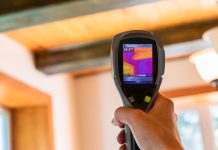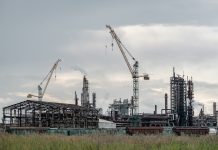Joanna Peacock, Sustainability Associate at Eight Associates, explains why your development may need an air quality assessment before you submit a planning proposal and what mitigation actions may be required
Air pollution is at crisis levels. According to the Royal College of Physicians, 40,000 deaths a year in the UK are attributable to outdoor air pollution, while recent research shows that every person in London is breathing air that exceeds World Health Organisation (WHO) limits for a damaging type of particle known as PM2.5.
Air quality standards are concentrations recorded over a given time period that are considered to be acceptable in terms of the effects of each pollutant on health and on the environment. These pollutants, measured in μg/m3, include particulate matter PM10 and PM2.5, nitrogen dioxide (NO2), ozone and sulphur dioxide. The UK has National Air Quality Objectives (NAQOs) and an EU limit with which to comply, but these are frequently – and in London, constantly – exceeded.
A main factor causing this air pollution is diesel combustion, from cars and also diesel-powered machines, such as diggers used on construction sites. In 2015 in London, it was estimated that up to 12% of NO2 and 15% of PM pollution came from construction and demolition activity.
Planning policies promote compliance with or contribute towards achievement of EU limit values and NAQOs, taking into account the presence of Air Quality Management Areas and the cumulative impact on air quality from individual sites in local areas. Where a local authority’s review and assessment of its air quality identifies that air quality is likely to exceed the NAQOs, it designates these areas as Air Quality Management Areas and draws up an Air Quality Action Plan. Developers should be aware that planning decisions will reflect compliance with the Local Air Quality Action Plan.
 An air quality assessment establishes the baseline air quality, including sensitive receptors (locations that may be affected by dust emissions during demolition and construction or emissions during operation). Detailed calculations are undertaken to establish the likely emissions with consideration of weather conditions and topography to determine the resulting concentration of pollutants at the proposed development.
An air quality assessment establishes the baseline air quality, including sensitive receptors (locations that may be affected by dust emissions during demolition and construction or emissions during operation). Detailed calculations are undertaken to establish the likely emissions with consideration of weather conditions and topography to determine the resulting concentration of pollutants at the proposed development.
Dust impacts during the construction phase and air quality impacts expected during the operation of the new development are assessed and a mitigation strategy to limit residents’ and local community exposure to elevated concentrations of air pollutants is provided, along with a consideration of whether the proposals would meet the Air Quality Neutral benchmark emissions.
The overall sensitivity of the development area to dust soiling, human health impacts and ecological receptors is determined by reviewing the sensitivity of the receptors and distance from the source.
A ‘human receptor’ refers to any location where a person or property may experience the adverse effects of airborne dust or dust soiling, or exposure to PM10 over a time period relevant to the air quality objectives. An air quality assessment will normally be required where there is a human receptor within 350m of the boundary of the site or if there is an ‘ecological receptor’, such as a waterway, within 50m of the boundary of the site. In both cases, an air quality assessment is likely to be required if receptors are within 50m of the route used by construction vehicles on the public highway, up to 500m from the site entrance.
A review of potential industrial pollution sources should also be undertaken to identify any significant industrial or waste management sources of air pollution that are likely to affect the proposed development.
Mitigation measures start at the design stage, including green infrastructure design, such as green roofs and walls, has a significant role in air pollution mitigation in addition to other benefits including reducing energy consumption, managing water runoff and improving biodiversity.
Landscaping with hedges is effective in improving air quality by capturing pollutant particles in ‘street canyon’ settings, while vegetation barriers are important in an open road context.
How to control and limit dust dispersion during the construction phase will be set out in the Dust Management Plan, including a stakeholder communications plan. This is where all dust and air quality inspections and complaints should be recorded, along with the source and action taken.
Before demolition, measures might include soft stripping inside buildings to provide a screen against dust and ensuring effective water suppression is used during demolition operations.
During the earthworks phase, earthworks and soil stockpiles should be re-vegetated to stabilise surfaces as soon as practicable. Other measures could include erecting solid screens or barriers around dusty activities or the site boundary that are at least as high as any stockpiles on site.
All vehicles should switch off engines when stationary, and there should be an adequate water supply on the site for effective dust and particulate matter suppression. Water-assisted dust sweepers should be used on the access roads and hard surfaced haul routes should be installed and regularly cleaned.
The site’s parking spaces and proximity to road and rail links influences the transport impacts on air quality. For example, if there will be road humps used to limit traffic speeds and improve safety, these can increase emissions through vehicles braking and then accelerating. Developing a detailed travel plan that encourages sustainable means of transport mitigates the impact of increased traffic.
An efficient plant specification, as part of the development’s energy strategy, can have a positive impact on air quality. Low NOx gas condensing boilers, air handling units with separate supply and extract fans or heat recovery units to reduce energy demand all have an impact in protecting future building users from poor air quality.
Undertaking an air quality assessment is often a requirement of the planning process, and essential for developers concerned with public health and wellbeing. Having this intelligence as early as possible means the most effective set of mitigation measures can be developed and implemented.
Joanna Peacock
Sustainability Associate
Eight Associates
Tel: +44 (0)20 7043 0418
Twitter: @eightassociates














